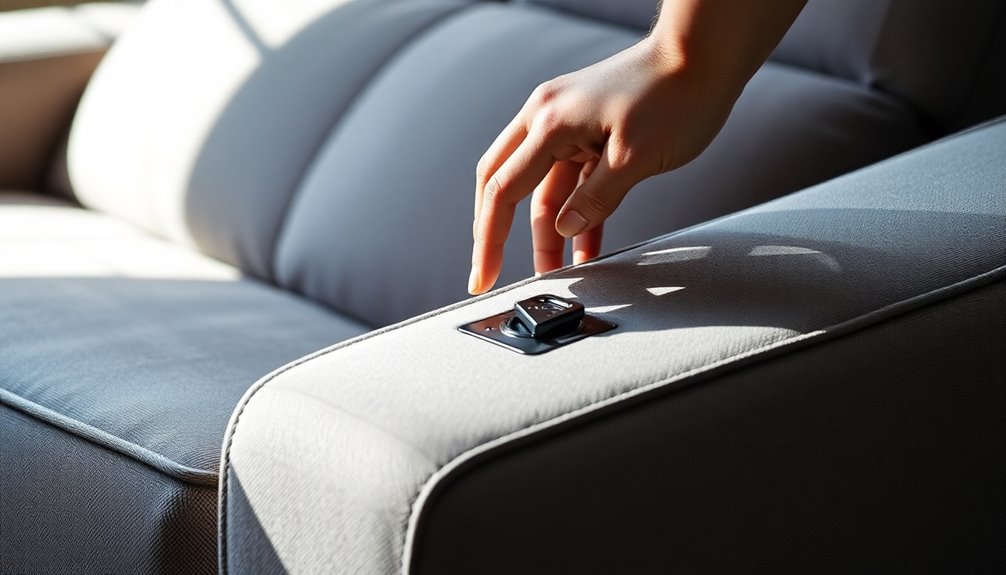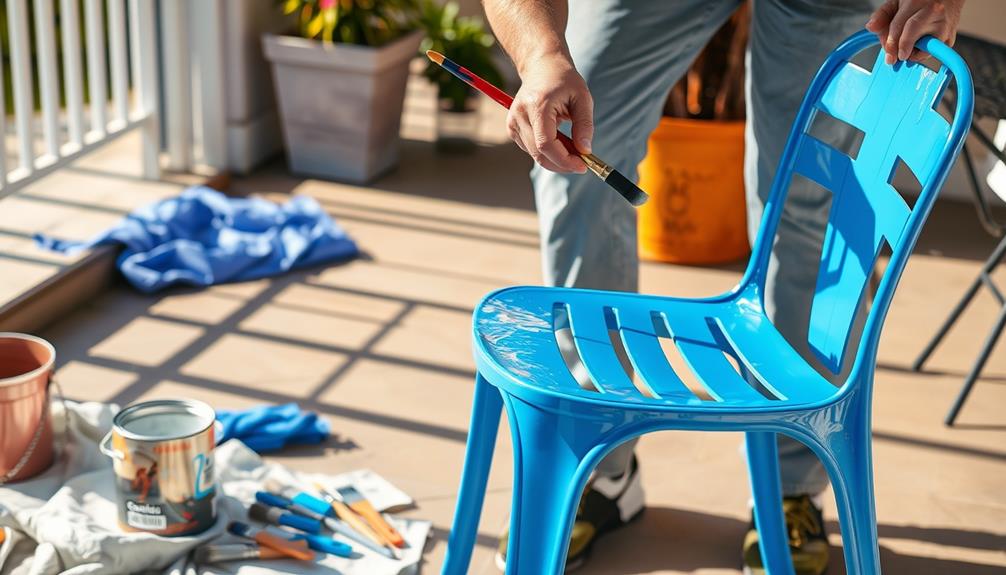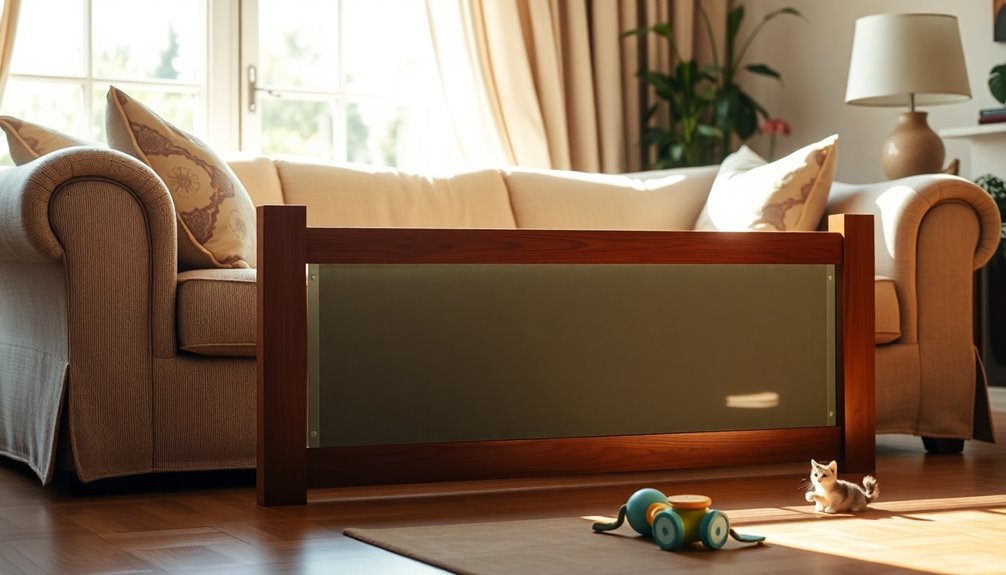To remove the back of your recliner sofa, start by locating the release levers or screws at the rear. If your model has levers, pull them while gently lifting the back. For screw-type models, use a screwdriver to unscrew and carefully detach the back. Ensure you support the back properly as you lift to prevent damage. Once removed, inspect for any wear or damage. Reattach by reversing these steps. You'll want to maintain the rest of your recliner, too, and there's more helpful info on that waiting for you!
Key Takeaways
- Check the manufacturer's instructions for specific guidance on removing the back of your recliner sofa.
- Locate the release mechanism, often found at the base or sides of the backrest.
- Gently pull or lift the backrest upward to detach it from the frame.
- Ensure all screws or bolts are removed if applicable before attempting to lift the back.
- If resistance is encountered, double-check for hidden fasteners or levers that may need to be disengaged.
Introduction
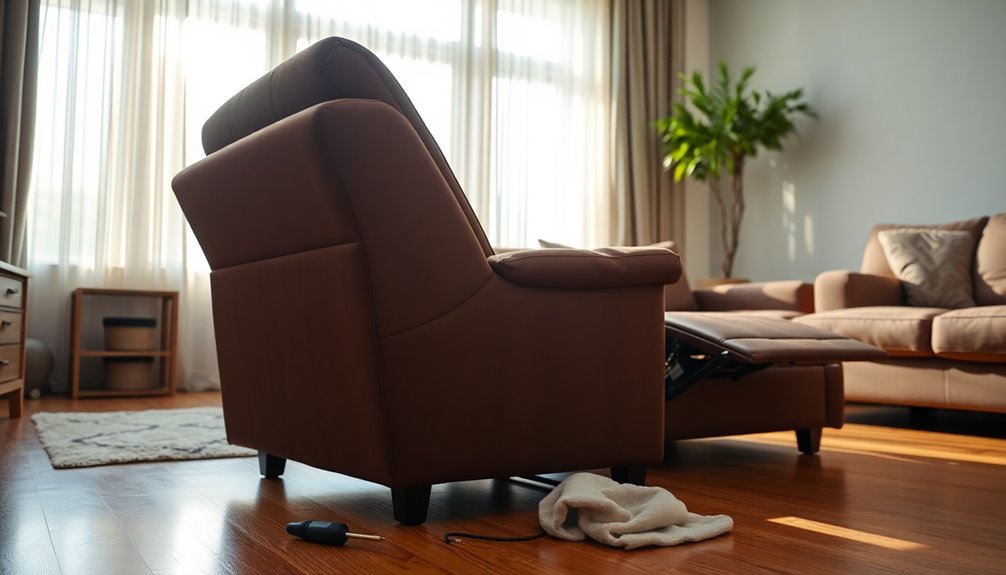
When it comes to keeping your recliner sofa in top shape, routine upholstery care is key. You'll want to know the best cleaning techniques for different materials, especially if you've got to tackle tough stains like pet urine. Let's explore how to maintain your sofa while also making sure you can easily remove and reattach the back when needed.
Routine Upholstery Care Tips
Caring for your recliner sofa is essential to keep it looking great and lasting for years. To start, make sure you regularly vacuum your upholstered sofa using a soft brush attachment. This helps remove dust, dirt, and debris that can accumulate in the fabric fibers. If you notice any stains, promptly blot the area with a clean, damp cloth. Use a mild upholstery cleaner that's specifically designed for your sofa's fabric type to avoid damage.
Additionally, make sure to rotate and fluff the cushions periodically. This simple action helps maintain their shape and prevents uneven wear, ensuring your recliner remains comfortable and visually appealing. It's also crucial to avoid direct sunlight exposure to prevent fading and discoloration. Consider using window treatments to protect your furniture from harsh rays.
Lastly, make sure to schedule professional upholstery cleaning every 1-2 years. This deep clean not only maintains the appearance of your recliner but also enhances its hygiene. By following these routine care tips, you'll keep your recliner sofa in excellent condition for years to come.
Material-Specific Cleaning Techniques
Maintaining the appearance and longevity of your recliner sofa hinges on using the right cleaning techniques for its specific material. Each type—leather, fabric, or microfiber—requires tailored care to avoid damage and keep it looking its best.
For leather recliners, you should use a damp cloth along with a pH-balanced leather cleaner. This combination helps prevent the leather from drying out and cracking. Always apply the cleaner gently and avoid soaking the material.
If your recliner is made from fabric, start by vacuuming to remove any loose dirt or debris. After that, use a fabric-safe cleaner or upholstery shampoo for spot cleaning. This method helps tackle stains without harming the fabric itself.
Microfiber sofas require a bit more attention. Mix water with mild soap and use a soft cloth to gently scrub the surface. Be careful not to saturate the material, as excess water can cause damage.
Always check your manufacturer's care label for specific cleaning instructions and recommended products. Tailoring your cleaning approach to the material not only preserves its beauty but also extends the life of your recliner sofa.
Tackling Pet Urine Stains
Dealing with pet urine stains on your recliner sofa can feel overwhelming, but quick action can make all the difference. First, grab some paper towels and gently blot the stained area to absorb as much liquid as possible. Avoid rubbing, as this can spread the stain and damage the fabric.
Next, consider using an enzymatic cleaner specifically designed for pet stains. These cleaners break down the proteins in urine, helping to eliminate both the stain and any lingering odors. Apply according to the product instructions for the best results.
If the stain persists, you can try a homemade solution of vinegar and water. Mix equal parts vinegar and water, but be sure to test it on an inconspicuous area of your sofa first to avoid any potential damage.
Regular cleaning and maintenance are crucial. Untreated stains can lead to long-term discoloration, which might require professional cleaning services to restore your fabric fully. By acting quickly and using the right products, you can keep your recliner looking fresh and free from unwanted odors.
Sofa Shielding Techniques
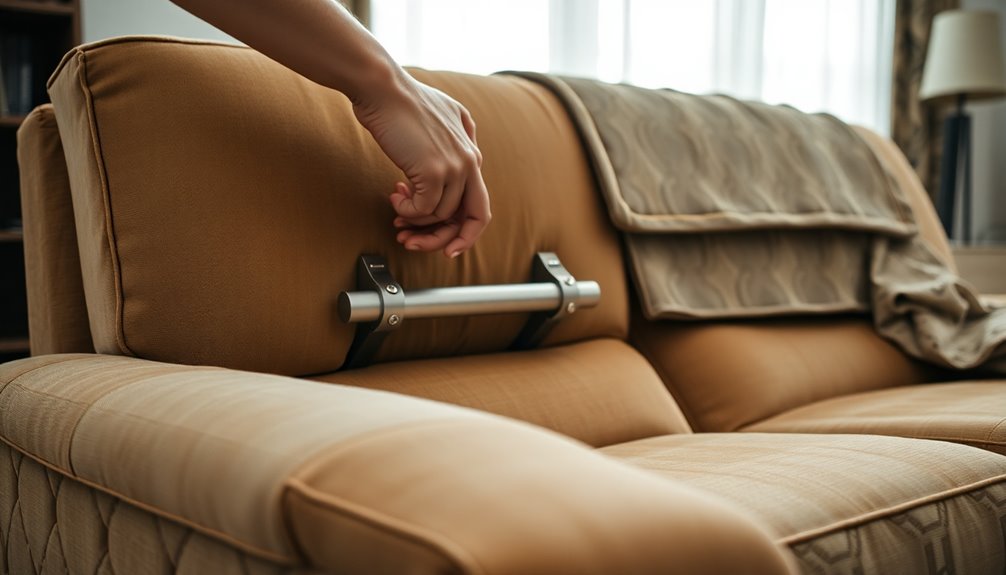
When it comes to protecting your reclining sofa, choosing durable fabrics is key. You can also explore protective fabric options that minimize friction and scratches, ensuring your upholstery stays in great shape. By implementing these strategies, you'll significantly extend the life of your sofa.
Durable Fabric Selection
Choosing the right fabric for your recliner sofa can make all the difference in its durability and longevity. High-performance materials like polyester and nylon blends are excellent choices, as they resist wear, tear, and fading. When selecting your fabric, consider options that have been treated with stain-repellent finishes, like Teflon, to help keep spills and stains at bay.
Pay attention to the Martindale rub count; aim for 30,000 or more. This number indicates the fabric's durability under daily use, ensuring your sofa withstands the test of time. Additionally, look for upholstery with tight weaves or patterns that can effectively hide minor wear and scratches, prolonging the sofa's lifespan.
Regular maintenance is crucial. Make it a habit to vacuum your sofa and apply fabric protectants to maintain its appearance and functionality. This simple step can significantly prolong the life of your durable fabrics, keeping your recliner sofa looking fresh and inviting for years to come. By choosing wisely and caring for your fabric, you can enjoy your recliner sofa without worrying about premature wear and tear.
Protective Fabric Options
Protecting your recliner sofa is essential for maintaining its pristine condition and longevity. One effective way to shield your furniture is by using protective fabric covers. These covers can prevent stains, spills, and everyday wear, extending the life of your sofa. Opt for high-quality fabric protectors made from microfibers or treated cotton blends, as they resist pet hair and scratches while allowing the fabric to breathe.
Regularly applying stain repellents is another smart move. This significantly reduces the likelihood of permanent stains, especially on light-colored upholstery. If you're looking for convenience, consider using slipcovers. They offer an added layer of protection and make cleaning hassle-free since they're easy to remove and wash.
Investing in sofa shields not only enhances the aesthetic appeal of your recliner but also safeguards it against daily wear and tear. Additionally, regular application of essential oils can help maintain a fresh scent in your living space. By taking these simple steps, you can preserve your furniture's appearance and enjoy your recliner for years to come. Remember, the right protective fabric options can make all the difference in keeping your sofa looking new.
Minimizing Friction and Scratches
To minimize friction and scratches during the transport of your recliner sofa, employing effective shielding techniques is crucial. Start by covering the surface of the sofa with moving blankets or furniture pads. This not only cushions the upholstery but also reduces the chance of scratches as you maneuver through tight spaces.
Next, use sliders or furniture glides under each leg of the sofa. These handy tools allow the sofa to glide smoothly over floors, minimizing damage to both the sofa and the flooring beneath. When lifting or moving the sofa, grip it firmly, and avoid dragging it. Dragging can lead to unsightly scratches on the upholstery and floor. Additionally, consider how to style a throw blanket when arranging your sofa for a cozy look. A well-placed throw can add color and texture, making the space more inviting. Experiment with draping it casually over one arm or layering it with decorative pillows for an aesthetically pleasing arrangement.
Consider investing in a sofa shield or protective wrap specifically designed for moving furniture. This adds an extra layer of protection against potential scratches and scuffs. Always lift from the base of the sofa, using proper lifting techniques. This prevents unnecessary stress on the frame and upholstery, ensuring your recliner sofa remains in great condition during the move. Additionally, having a vacuum with a high filtration efficiency will help maintain the cleanliness of your space, minimizing dust and allergens that could settle on your furniture. By following these steps, you'll keep your sofa looking pristine while safeguarding your home's surfaces.
Routine Component Inspections
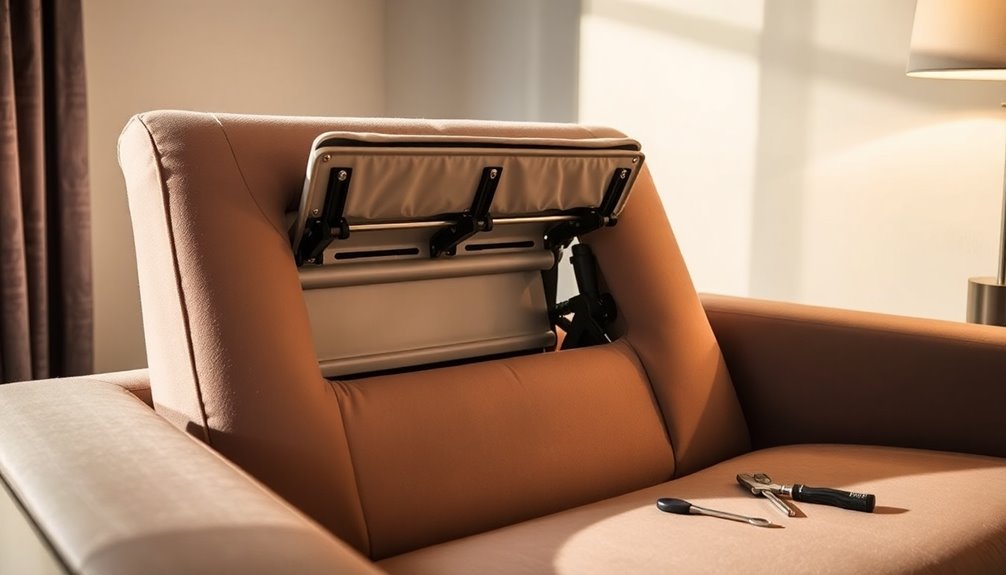
It's essential to keep an eye on the overall condition of your recliner sofa during routine inspections. Checking for frame stability, refreshing the fabric or leather, and fluffing the cushions can help maintain its comfort and appearance. By addressing these components regularly, you can ensure your recliner remains functional and inviting for years to come.
Frame Stability Concerns
Regular inspections of your recliner sofa's frame are crucial for maintaining its stability and performance. Start by examining the joints and connection points where the back meets the seat for any signs of wear or damage. These areas are often the most vulnerable, and addressing issues early can prevent bigger problems down the line.
Next, ensure that the levers used for disassembly are functioning correctly. A malfunctioning lever can compromise the frame's stability during the removal process, leading to potential hazards. Also, check for any loose screws or bolts in the frame. Tightening these components is essential, as loose hardware can lead to instability and affect the reclining mechanism's performance.
Don't forget to assess the condition of removable components, like flaps or brackets. These should securely attach the back to the frame without any risk of detachment during use. Lastly, maintain a clean and debris-free area around the frame to prevent obstructions. A clutter-free space allows for safer removal and reattachment of the back, ensuring your recliner sofa remains stable and functional.
Fabric and Leather Revitalization
Maintaining the frame stability of your recliner sofa is just one part of keeping it in top shape; the upholstery also deserves attention. Regular inspections of both fabric and leather can prevent long-term damage and help maintain your sofa's aesthetic appeal. Look for signs of wear, such as fraying seams, discoloration, or cracking in the leather. Addressing these issues early means you can avoid more costly repairs down the line.
During your routine maintenance, use a gentle cleaner specifically formulated for either fabric or leather. This helps remove dirt and stains without causing further damage. Additionally, consider applying a fabric protector or leather conditioner to enhance durability and resist spills and stains. Regular cleaning of your upholstery can also help prevent the buildup of harmful bacteria that can affect your home environment.
To keep your upholstery looking its best, schedule professional cleaning every one to two years. This rejuvenates the fabric or leather and extends the lifespan of your reclining furniture. By staying on top of these inspections and maintenance tasks, you can enjoy your recliner sofa for years to come, ensuring it's not only comfortable but also visually appealing.
Cushion Fluffing Techniques
Cushion care is essential for keeping your recliner sofa comfortable and inviting. Regularly inspect your cushions for signs of flattening or sagging. If you notice these issues, it's time to fluff or consider replacing them. To fluff cushions, gently knead and shake them by hand. This redistributes the filling evenly and helps restore their original shape.
Using a vacuum cleaner with an upholstery attachment can greatly assist in maintaining your cushions. By removing debris, you allow for better fluffing and extend the life of the fabric. If your cushions are made of foam, try placing them in the sun for a few hours. The heat helps evaporate moisture, rejuvenating their firmness.
Don't forget to rotate and flip your cushions regularly. This simple practice promotes even wear and can prevent sagging over time. By taking these steps, you'll maintain the comfort and appearance of your recliner sofa, ensuring it remains a cozy spot in your home. So, make it a habit to check and fluff those cushions to keep your seating as inviting as ever!
Personalized Fabric Choices
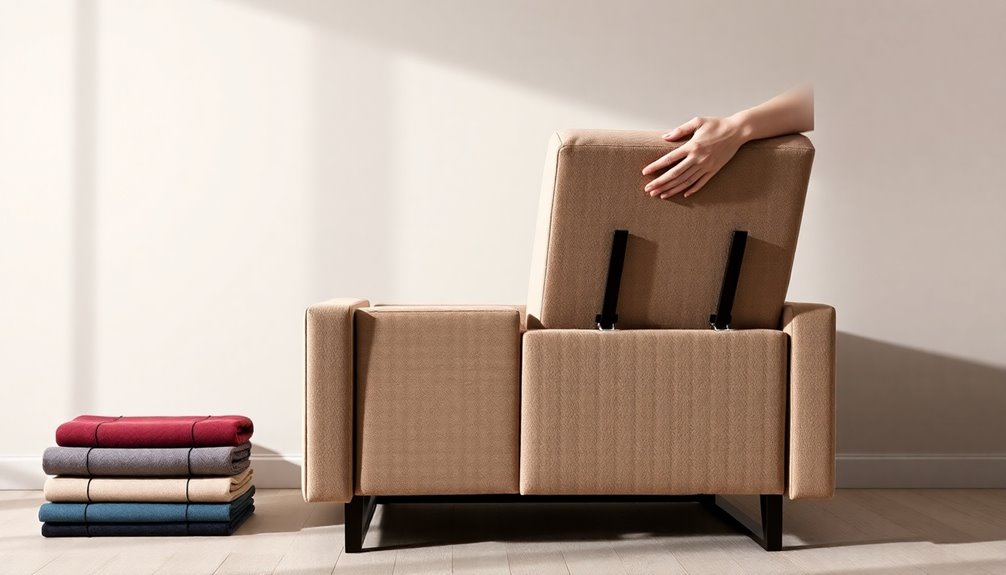
Have you ever wondered how personalized fabric choices can transform your reclining sofa? Selecting the right fabric can enhance both the aesthetics and comfort of your living space. You can choose colors and textures that harmonize with your decor, making your sofa a focal point in the room.
Many manufacturers offer a wide range of fabric options, including performance fabrics that resist stains and wear. This ensures your sofa remains stylish while standing up to everyday life. With custom upholstery, you can select materials like leather, microfiber, or cotton, each offering unique benefits in maintenance and feel.
If you're looking for a tailored look, some brands allow you to choose contrasting stitching or patterns to give your recliner a personalized touch. This option adds character and style, making your sofa truly yours. Plus, for environmentally conscious consumers, personalized fabric choices often include eco-friendly materials, allowing you to prioritize sustainability in your furniture selection.
Aging Sofa Maintenance Strategies
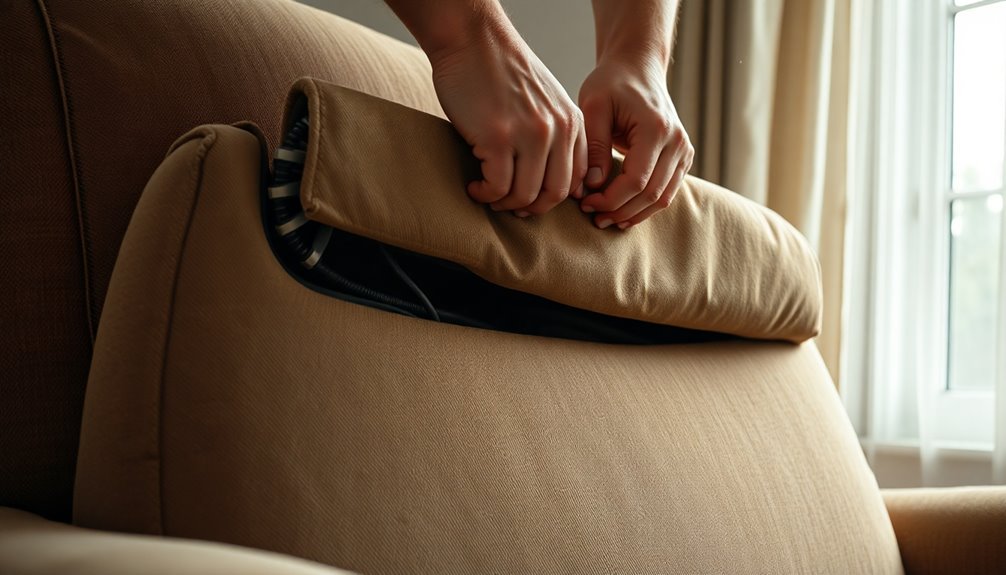
To keep your aging sofa in top shape, it's essential to adopt a proactive maintenance routine. Start by regularly inspecting the reclining mechanisms and upholstery for any signs of wear or malfunction. Catching issues early can save you from more extensive repairs later.
Next, clean the fabric or leather surfaces with appropriate cleaners to prevent dirt buildup. Dirt can accelerate deterioration, so make this a part of your regular cleaning schedule. For leather sofas, consider applying fabric protectors or conditioners to preserve the material and enhance its longevity.
Don't forget to check the frame and mechanism for loose screws or bolts. Tightening these can ensure stability and prevent further damage from excessive movement.
Additionally, rotate and fluff cushions periodically. This simple step helps maintain their shape and support, extending the lifespan of your sofa.
Conclusion
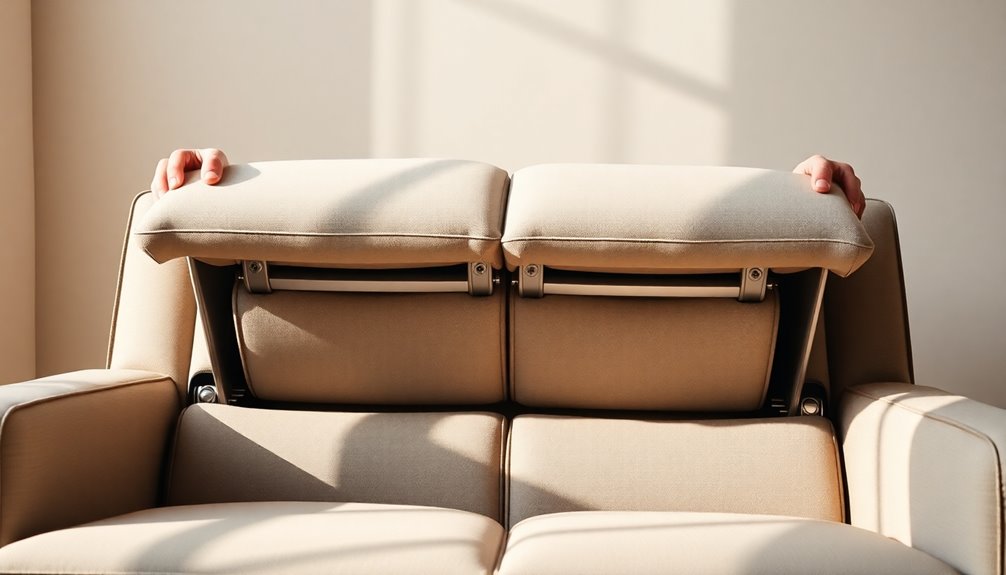
Removing the back of your recliner sofa can seem daunting, but with the right steps, it's a straightforward process. Start by inspecting the sofa for a removable flap, which could be secured with adhesive or Velcro. This flap often indicates that the back can be detached. Next, locate the distinct levers on each side of the chair's frame. By pulling these levers, you'll initiate the back's removal process.
Once the levers are engaged, the back should slide off easily, making transportation more manageable. When you're ready to reassemble the recliner, simply center the back on the frame and push down until you hear a click. This sound confirms that it's securely attached. Make sure both sides of the back are properly engaged to maintain stability and functionality.
Frequently Asked Questions
How Do You Remove the Back of a Recliner Couch?
To remove the back of a recliner couch, start by inspecting the back for a flap that might hide levers or fasteners. You'll want to locate those distinct levers on either side of the frame. Pull them out to engage the removal process. Once engaged, the back should slide off easily, making it easier to transport. Just remember to reattach it securely by pushing down until you hear a click!
Do All Reclining Sofas Have Removable Backs?
Not all reclining sofas have removable backs. It really depends on the manufacturer and model. Some are designed for easy transport and feature detachable backs, while others may not. You might find hidden levers or flaps indicating that the back can come off, but older models often lack this convenience. To find out if your specific sofa has a removable back, check the manufacturer's instructions or guidelines.
Do All Recliner Backs Come Off?
Not all recliner backs come off. It really depends on the make and model of your sofa. Some recliners feature removable backs for easy transport, while others are designed as a single unit. You'll want to check for any Velcro or mechanisms that might indicate removability. If you're unsure, it's a good idea to consult the manufacturer's instructions or seek advice from furniture experts to clarify your specific recliner's capabilities.
How Do You Take Apart a Reclining Sofa for Moving?
To take apart a reclining sofa for moving, start by checking for any removable flaps at the back, which might be secured with Velcro or adhesive. Look for levers on each side of the sofa; pull these out to begin the disassembly. Once engaged, the back should slide off easily. When you're ready to reassemble, align the back with the frame and push down until you hear a click, ensuring it's secure.
